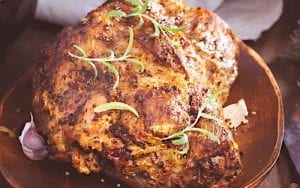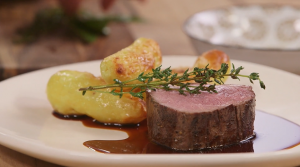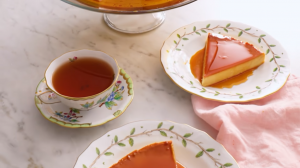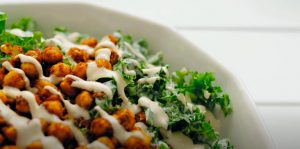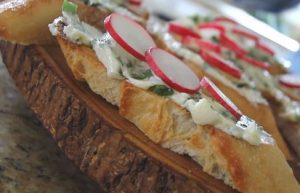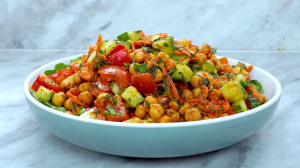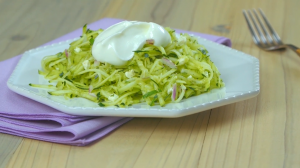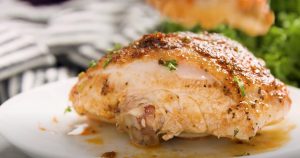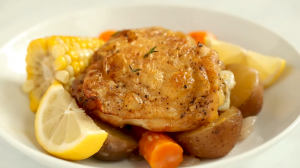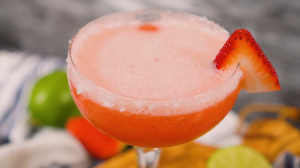This recipe for roasted beef tenderloin with wine sauce is a luxurious and indulgent dish. The succulent beef tenderloin is roasted to perfection and served with a rich, flavorful wine sauce. It's a dish that's sure to impress at any dinner party or special occasion.
Most of the ingredients for this recipe are common pantry staples like butter, flour, and vegetable oil. However, you might need to make a trip to the supermarket for some items. The key ingredient, beef tenderloin, is a premium cut of beef that is famed for its tenderness and flavor. Additionally, you will need red wine for the sauce - a good quality wine that you enjoy drinking will give the best result.
Ingredients for Roasted Beef Tenderloin with Wine Sauce
Unsalted butter: Used to sauté the shallots and create a roux for the wine sauce.
Shallots: Adds a mild, sweet flavor to the sauce.
Red wine: Used in the sauce, imparts a rich, deep flavor.
Beef broth: Adds savory depth to the sauce.
Thyme sprigs: Gives the sauce a subtle, earthy flavor.
Kosher salt: Enhances the flavors of the other ingredients.
Ground black pepper: Adds a mild heat to the beef and the sauce.
Sugar: Balances the acidity of the wine.
All-purpose flour: Thickens the wine sauce.
Beef tenderloin roast: The star of the show, roasted to perfection.
Vegetable oil: Used to sear the beef before roasting.
One reader, Bethanne Earley says:





This roasted beef tenderloin with wine sauce recipe is a showstopper! The beef was incredibly tender and juicy, and the wine sauce added a rich, flavorful touch. It was a hit at our dinner party and I received so many compliments. I'll definitely be making this again!
Techniques Required
How to prepare the wine sauce: This involves melting butter, cooking shallots, adding wine, beef broth, thyme, salt, pepper, and sugar, and reducing the liquid. Then, making a paste with butter and flour, and thickening the sauce.
How to roast the beef tenderloin: This includes seasoning the beef, searing it in a skillet, roasting it in the oven, and letting it rest before carving.
How to make the red wine sauce: After roasting the beef, you can use the fond in the roasting pan to make a flavorful broth, which is then added to the red wine sauce and brought to a simmer.
How to carve the beef tenderloin: This involves slicing the tenderloin into 1/3-inch-thick slices before serving.
How To Make Roast Beef Tenderloin with Wine Sauce
Sink your teeth into this succulent roast beef tenderloin, that’s basted and roasted in a sweet thyme red wine sauce, for an indulgent dinner meal!
Serves:
Ingredients
For Sauce:
- 8tbspunsalted butter,divided
- ¾cupshallots,finely chopped
- 1¼cupred wine
- 3cupsbeef broth
- 6fresh thyme sprigs
- ¼tspkosher salt
- ⅛tspground black pepper
- 1tspsugar
- 2tbspall-purpose flour
For Beef:
- 2lbbeef tenderloin roast,center-cut
- 2tspkosher salt
- 2tspfreshly ground black pepper
- 2tbspvegetable oil
- ¼cupbeef broth
Instructions
-
Melt 5 tablespoons of the butter in a medium saucepan. Add the shallots and cook over medium-low heat, stirring occasionally, for 7 to 8 minutes, until soft and translucent.
-
Add the wine, beef broth, thyme sprigs, salt, pepper and sugar, and bring to a boil. Cook over medium heat for about 30 minutes, or until the liquid is reduced by about half.
-
While the liquid is reducing, place the remaining 3 tablespoons of butter in a small bowl and soften in the microwave, if necessary. Add the flour and, using a small spoon, mix into a smooth paste.
-
Once the wine mixture is reduced, reduce the heat to low and remove the thyme sprigs. Whisk the flour-butter paste, a teaspoonful at a time, into the simmering liquid, and simmer for a few minutes, until the sauce is thickened. Set aside.
-
Let the beef stand at room temperature for 1 hour before roasting.
-
Set an oven rack in the middle position and preheat the oven to 400 degrees F.
-
Season the beef all over with kosher salt and pepper. Heat the oil in an oven-proof skillet over medium-high heat until almost smoking. Cook, turning with tongs, for about 10 minutes total, until well browned on all but one side.
-
Turn the tenderloin so that the un-seared side is down, and transfer the skillet directly to the preheated oven.
-
Roast for about 15 minutes, until a thermometer inserted into the center of the meat registers 120 to 125 degrees F for medium rare, or until done to liking (115 to 120 degrees F for rare, 130 to 135 degrees F for medium). Keep in mind that these temperatures account for the fact that the temperature will continue to rise about 5 degrees while the meat rests
-
Transfer the meat to a carving board and let it rest, covered loosely with aluminum foil, for 10 to 15 minutes.
-
Carefully discard the fat from the roasting pan. Set the pan on the stovetop and add the ¼ cup of beef broth.
-
Bring the broth to a boil, using a wooden spoon to scrape the fond, or brown bits, from the bottom of the pan. Add the flavorful broth to the red wine sauce, and then bring the sauce to a simmer.
-
Carve the tenderloin into ⅓-inch-thick slices.
-
Serve the beef, passing the red wine sauce at the table, and enjoy!
Nutrition
- Calories: 484.94kcal
- Fat: 29.65g
- Saturated Fat: 13.38g
- Trans Fat: 1.12g
- Monounsaturated Fat: 10.89g
- Polyunsaturated Fat: 2.05g
- Carbohydrates: 10.15g
- Fiber: 1.34g
- Sugar: 3.30g
- Protein: 36.90g
- Cholesterol: 134.45mg
- Sodium: 885.81mg
- Calcium: 63.93mg
- Potassium: 850.61mg
- Iron: 5.27mg
- Vitamin A: 142.91µg
- Vitamin C: 6.40mg
Pro Tip for Achieving Perfect Results
When roasting the beef tenderloin, it's important to sear all sides before placing it in the oven. This process, known as browning, enhances the flavor of the meat through the Maillard reaction, a chemical reaction between amino acids and reducing sugars. Also, remember to let the meat rest after roasting. This allows the juices to redistribute throughout the roast, resulting in a moister and more flavorful dish.
Time-Saving Tips for Making This Recipe
Prep ahead: You can prepare the red wine sauce a few days in advance and store it in the refrigerator. This will save you time on the day of cooking.
Use an instant-read thermometer: Checking the beef's temperature with an instant-read thermometer will ensure that it's cooked to your desired level of doneness without overcooking.
Substitute Ingredients For Roast Beef Tenderloin with Wine Sauce Recipe
unsalted butter - Substitute with ghee: Ghee is a clarified butter that has a rich, nutty flavor and can be used as a substitute for unsalted butter in this recipe. It adds a depth of flavor and richness to the sauce.
shallots - Substitute with onions: Onions can be used as a substitute for shallots in the sauce. They provide a similar savory and slightly sweet flavor, complementing the dish well.
red wine - Substitute with beef broth: If you prefer not to use alcohol, beef broth can be used as a substitute for red wine in the sauce. It will still provide depth of flavor and richness to the sauce.
beef broth - Substitute with vegetable broth: Vegetable broth can be used as a substitute for beef broth in the sauce. It will provide a savory base and enhance the flavors of the dish.
fresh thyme sprigs - Substitute with dried thyme: Dried thyme can be used as a substitute for fresh thyme sprigs. Use a smaller quantity of dried thyme, as it is more concentrated in flavor.
kosher salt - Substitute with sea salt: Sea salt can be used as a substitute for kosher salt. It provides a similar level of saltiness and enhances the overall flavor of the dish.
ground black pepper - Substitute with white pepper: White pepper can be used as a substitute for ground black pepper. It has a slightly different flavor profile but will still add a pleasant heat to the dish.
all-purpose flour - Substitute with cornstarch: Cornstarch can be used as a substitute for all-purpose flour to thicken the sauce. It is a gluten-free alternative and provides a glossy finish to the sauce.
center-cut beef tenderloin roast - Substitute with pork tenderloin: Pork tenderloin can be used as a substitute for beef tenderloin. It has a similar lean and tender texture, and when cooked properly, it can be a delicious alternative.
vegetable oil - Substitute with olive oil: Olive oil can be used as a substitute for vegetable oil. It adds a fruity and aromatic flavor to the dish.
beef broth - Substitute with chicken broth: Chicken broth can be used as a substitute for beef broth. It provides a savory base and complements the flavors of the dish.
Plating Ideas for a Gourmet Look
Elevate the beef tenderloin slices: Arrange the beef tenderloin slices on the plate in an overlapping pattern, creating a visually appealing presentation.
Garnish with fresh herbs: Sprinkle the dish with freshly chopped parsley or thyme to add a pop of color and freshness to the plate.
Drizzle the wine sauce: Carefully drizzle the rich red wine sauce around the beef, ensuring it enhances the flavors without overpowering the dish.
Add a touch of elegance with microgreens: Place a small bundle of delicate microgreens on top of the beef for a sophisticated and refined touch.
Incorporate edible flowers: Introduce a few edible flowers such as nasturtiums or pansies to bring a touch of beauty and a subtle floral note to the dish.
Create a balanced composition: Pay attention to the placement of each element on the plate, ensuring a harmonious and visually appealing composition.
Use high-quality serving ware: Present the dish on elegant porcelain or ceramic plates to elevate the overall dining experience.
Consider the negative space: Embrace the beauty of simplicity by allowing some negative space on the plate, highlighting the main components of the dish.
Storage and Freezing Guidelines for Roasted Beef Tenderloin
Let the roasted beef tenderloin cool completely before storing it in an airtight container or wrapping it tightly with plastic wrap. This will help prevent the meat from drying out and maintain its juicy texture.
Store the cooled beef tenderloin in the refrigerator for up to 4 days. When ready to serve, slice the meat and reheat it gently in the oven or microwave until warmed through.
To store the wine sauce, let it cool to room temperature before transferring it to an airtight container. The sauce can be refrigerated for up to 5 days. Reheat the sauce in a saucepan over low heat, stirring occasionally, until warmed through.
For longer storage, you can freeze the roasted beef tenderloin. Wrap the cooled meat tightly in plastic wrap, followed by a layer of aluminum foil. Label the package with the date and contents, and freeze for up to 3 months.
To freeze the wine sauce, let it cool completely before transferring it to a freezer-safe container or zip-top bag. Label the container with the date and contents, and freeze for up to 3 months.
When ready to serve the frozen beef tenderloin, thaw it overnight in the refrigerator. Reheat the meat in the oven or microwave until warmed through. If the meat seems dry, slice it and serve it with the reheated wine sauce to help moisten it.
To serve the frozen wine sauce, thaw it overnight in the refrigerator. Reheat the sauce in a saucepan over low heat, stirring occasionally, until warmed through. If the sauce seems too thick, you can thin it out with a little beef broth or water.
How To Reheat Leftovers
The best way to reheat leftover roasted beef tenderloin is to slice it into thin pieces and gently warm it in a skillet over medium-low heat with a splash of beef broth or red wine. This method helps to keep the meat tender and prevents it from drying out.
Another option is to wrap the sliced beef tenderloin in aluminum foil with a few tablespoons of the wine sauce and place it in a preheated 325°F oven for about 10-15 minutes, or until heated through. The foil helps to lock in the moisture and keep the meat juicy.
For a quicker reheating method, place the sliced beef on a microwave-safe plate and drizzle a small amount of the wine sauce over the top. Cover the plate with a damp paper towel and microwave on 50% power in 30-second intervals until the meat is heated through. Be careful not to overheat, as this can cause the meat to become tough.
If you have a sous vide machine, you can reheat the beef tenderloin by placing it in a sealed bag with a small amount of the wine sauce and heating it in a water bath set to 120°F for about 30 minutes. This method ensures even heating and helps to maintain the meat's original texture and flavor.
To reheat the wine sauce, pour it into a small saucepan and gently warm it over low heat, stirring occasionally. If the sauce has thickened too much, you can thin it out with a splash of beef broth or red wine. Be sure to taste the sauce and adjust the seasoning as needed before serving.
Random Fact about Roasted Beef Tenderloin with Wine Sauce
The recipe for roasted beef tenderloin with wine sauce is a classic dish that is often served during special occasions and holidays. It is a popular choice for festive gatherings and celebrations due to its elegant presentation and delicious flavors. This dish pairs well with a variety of side dishes such as mashed potatoes, roasted vegetables, or a fresh salad. The red wine sauce adds a rich and savory element to the tenderloin, enhancing its overall taste. It's a great option for a special dinner or when hosting a dinner party.
Is Making This Dish at Home Cost-Effective?
This roasted beef tenderloin with wine sauce recipe is moderately cost-effective for a household. The use of beef tenderloin and red wine may make it slightly more expensive, but the dish is perfect for special occasions or a luxurious family dinner. The approximate cost for a household of 4 people would be around $50-$60. The rich flavors and elegant presentation make it a standout dish, earning a solid 8/10 rating for its taste and appeal.
Is This Dish Healthy or Not So Much?
The roasted beef tenderloin with wine sauce recipe is a delicious and indulgent dish, but it may not be the healthiest option. Here's why:
- The recipe uses a significant amount of butter, which is high in saturated fat and calories.
- Red meat, like beef tenderloin, is often associated with increased risk of heart disease and certain cancers when consumed in excess.
- The red wine sauce, while flavorful, adds extra calories and alcohol to the dish.
However, there are some positive aspects to this recipe:
- Beef tenderloin is a lean cut of meat, which means it is lower in fat compared to other cuts of beef.
- The recipe includes shallots, which are a good source of vitamins and minerals, such as vitamin C, potassium, and antioxidants.
- The use of fresh thyme adds a pop of flavor and some potential health benefits, as herbs often contain antioxidants and anti-inflammatory compounds.
To make this recipe healthier, consider the following suggestions:
- Reduce the amount of butter used in the sauce, or replace some of it with a healthier alternative like olive oil.
- Serve smaller portions of the beef tenderloin and pair it with a variety of nutrient-dense side dishes, such as roasted vegetables or a leafy green salad.
- Use a low-sodium beef broth to reduce the overall sodium content of the dish.
- Experiment with using a smaller amount of red wine in the sauce, or replace it with a low-calorie, alcohol-free alternative like beef stock or pomegranate juice.
- Consider using a different lean protein, such as chicken or turkey breast, for a healthier alternative to red meat.
Editor's Take on This Delectable Dish
The recipe for roasted beef tenderloin with wine sauce is a classic and elegant dish that is sure to impress. The method of roasting the beef tenderloin to perfection and pairing it with a rich red wine sauce creates a luxurious and flavorful experience. The detailed instructions ensure that the beef is cooked to the desired level of doneness, and the wine sauce adds a beautiful depth of flavor. This dish is perfect for special occasions or entertaining guests, and the combination of tender beef and savory sauce is a true delight for the senses.
Enhance Your Roast Beef Tenderloin with Wine Sauce Recipe with These Unique Side Dishes:
Similar Recipes to Try If You Enjoyed This Beef Tenderloin Dish
Appetizer and Dessert Ideas to Complement Your Beef Tenderloin Meal
Why trust this Roast Beef Tenderloin with Wine Sauce Recipe:
This recipe guarantees a succulent and flavorful beef tenderloin that will impress even the most discerning palates. The red wine sauce is a rich and luxurious complement, adding depth and complexity to the dish. With carefully selected ingredients and precise instructions, this recipe promises a restaurant-quality experience in the comfort of your own home. Trust in the expertise and attention to detail that has gone into crafting this culinary masterpiece. Embrace the opportunity to elevate your dining experience with this exquisite roasted beef tenderloin with wine sauce recipe.
Was this page helpful?
Have your own special recipe to share? Submit Your Recipe Today!




